Apple iPhone 4S: Thoroughly Reviewed
by Anand Lal Shimpi & Brian Klug on October 31, 2011 7:45 PM EST- Posted in
- Smartphones
- Apple
- Mobile
- iPhone
- iPhone 4S
Improved Baseband - No Deathgrip
We’ve mentioned already that the 4S is more of an evolution of the CDMA iPhone 4 than the GSM/UMTS iPhone 4, and where that’s most obvious is again is its cellular architecture. When we reviewed the GSM/UMTS iPhone 4, we investigated and explained why its design made it especially prone to unintended attenuation when held a certain way. Apple remedied the situation somewhat by giving away free cases, but only in the case of the CDMA iPhone 4 was the fundamental design issue remedied by adding receive diversity with a second cellular antenna at the top.
The 4S builds on this architecture by incorporating the same diverse receive path with two U shaped antennas at top and bottom, and adding transmit diversity to the equation. I’m being a bit fast and loose with the term “diversity” here, since the 4S cannot transmit simultaneously on both antennas, but rather switches between the two antennas based on which has the least receive fading. Receive diversity is a bit more interesting to explain, since the 4S appears to be able to dynamically decide whether to select one of the two receive paths (in the case that one is much more faded than the other), or combine the two (using something like maximal-ratio combining) and get a better quality equivalent signal.
When I talked about the CDMA 4’s receive diversity scheme, I went into detail to prove that this feature was present. With the 4S, these diversity features are much easier to talk about because Apple has been directly forthcoming about the feature this time. In addition, the transmit switching part of the equation is discussed at length in Apple’s FCC disclosure (since the FCC is interested in scrutinizing transmitters), and even includes a nice diagram.
The device is capable of switching between the Primary/ANT1 and Secondary/ANT2 Antennas. The antenna switching is implemented with a physical, "break-before-make" switch such that only one antenna can be used for cellular transmission at a time.
To re-state the evolution that Apple has taken with this design, the GSM/UMTS 4 had one transmit and receive chain, the CDMA 4 added a second receive chain for diversity, and the 4S now has two receive chains and the ability to switch between two transmit chains. The result is that the phone no longer is prone to fading on either the forward or reverse link due to being held near the feed points for one chain.
To be totally thorough, you can immediately see that the 4S still incorporates the same overall design however, complete with a a U.FL connector at the bottom and a feed cable that runs up the side of the PCB to the top. From here it obviously terminates somewhere that makes contact with the top antenna.

Encircled in red: Top antenna feed cable (Original photo courtesy iFixit)
When we saw that the CDMA iPhone used Qualcomm’s MDM6600, we made an educated guess that the next device would likely be based on the same baseband. It turned out that this was pretty close to the case, as the iPhone 4S uses an unannounced Qualcomm MDM6610.
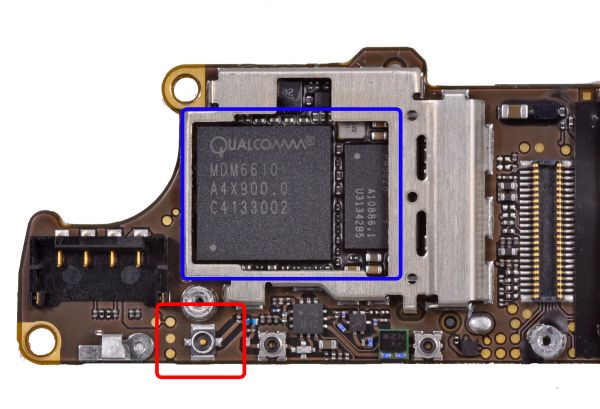
Encircled in blue: Qualcomm MDM6610 and PM8028, Red: Bottom antenna U.FL connector. Note to the right the two test pads for the two chains. (Original photo courtesy iFixit)
There are some immediate differences that stick out about MDM6610 versus MDM6600. First, 6610 doesn’t appear to include an internal transceiver, unlike MDM6600 which previously included a transceiver in its package. MDM6610’s package is correspondingly smaller, at 10x10 mm, compared to 6600’s 9.8x12.2 mm, but again you have to factor in the fact that the transceiver isn’t inside that package anymore. Based on those facts and the state of 28nm maturity, it’s almost certain that MDM6610 is still a 45nm part. The 4S uses Qualcomm’s RTR8605 IntelliCeiver transceiver for cellular RF management and also for GLONASS/GPS. We’ve seen RTR8600 before, and RTR8605 appears to just be an improvement upon that part with the same functionality. In fact, inside the MDM6610’s AMSS it’s just referred to as RTR8600.
Qualcomm isn’t ready to talk at all about MDM6610, but I’ve done a little digging and know more about this part. First off, it’s referred to as codename “Trek” inside the Qualcomm AMSS (Advanced Mobile Subscriber Software), whereas MDM6600 in the CDMA iPhone was referred to as “Phoenix.” When we first saw that the 4S was using a baseband that hasn’t been announced, we assumed it was an Apple specific one-off. However, after some digging I uncovered a reference to a GSM/UMTS only part as well: “MDM6210MDM6610”. For those that aren’t familiar, the 2 connotes GSM/UMTS compatibility, 6 adds 1x/EVDO. Apple appears to have secured MDM6610 exclusivity for the time being, but I expect we’ll see a more formal announcement of the MDM6x10 family down the road. This is pretty much par for the course for Apple when it comes to component sourcing.
| iPhone 4S - Network Support | |||||
| GSM/EDGE Support | 850 / 900 / 1800 / 1900 MHz | ||||
| UMTS/HSDPA/HSUPA Support | 850 / 900 / 1900 / 2100 MHz | ||||
| HSDPA/HSUPA Speeds | 14.4 Mbps / 5.76 Mbps | ||||
| CDMA2000 1x/EVDO Support | EVDO Rev.A (800 / 1900 MHz) | ||||
| Baseband Hardware | Qualcomm MDM6610 | ||||
MDM6610 also appears to inherit all the air interfaces that MDM6600 had, including WCDMA/HSPA+ with HSDPA 14.4, HSUPA 5.76, GSM, CDMA 1x/EVDO (up to Rev.B, though Apple notes only A is used at present), and finally GPS/GLONASS. Superficially, there don’t appear to be any major differences beyond using an external transceiver to accommodate diversity and transmit switching. In addition, the 4S contains all the same bands as the GSM/UMTS iPhone 4.
I was initially worried that Apple would go the same route that it did with both iPhone 4 launches and initially not include FieldTest. Thankfully, the 4S includes FieldTest right out of launch, which works for both CDMA and GSM/UMTS provisioned 4Ses.

iPhone 4S Field Test under CDMA Mode
There’s a corresponding difference in the interface for the two modes. On CDMA iPhone 4S mode, there are tabs for 1x and EVDO, and Rx signal strength fields for both receive paths, as well as the current transmit power. What’s interesting here is that when using the 4S in CDMA mode, you can see the receive strength change for each antenna when held.
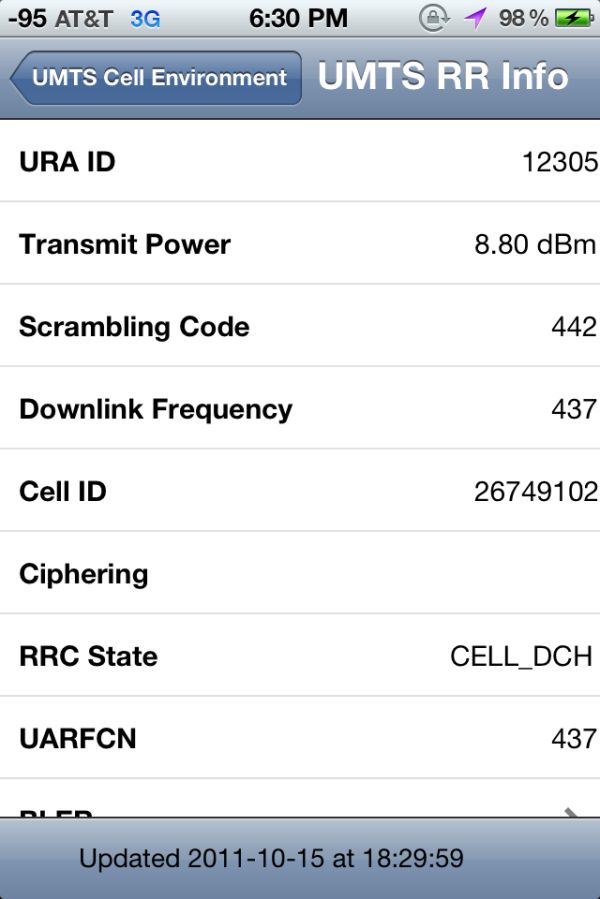
iPhone 4S Field Test under UMTS/GSM Mode
On the GSM/UMTS provisioned iPhone 4S, you don’t get individual receive strength for each chain, instead just the effective RSCP from either the selected chain or combined. If you grip the phone while watching this, you can sometimes watch RSCP race to –130 dBm and then switch entirely to the other antenna and race back up to an acceptable number. As a reminder, to get into FieldTest dial *3001#12345#* - you can then keep numerics instead of bars in the top left by force quitting FieldTest after launching it (hold down power/lock until power off appears, then hold the home button).
So how does the 4S do in our actual attenuation testing? Very well actually. I watched the RSCP of one NodeB and held the 4S all the same ways we’ve done since the 4, recorded a bunch of data, and averaged it together. What we’re measuring here is reported in dBm, and less attenuation is better (0 dBm = 1 mW).
| Signal Attenuation Comparison in dB - Lower is Better | ||||||||
| Cupping Tightly | Holding Naturally | Holding in Case | On an Open Palm | |||||
| iPhone 4S | 10.8 | 8.8 | - | 4.3 | ||||
| CDMA iPhone 4 | 16.5 | 15.5 | 9.0 | 7.9 | ||||
| GSM/UMTS iPhone 4 | 24.6 | 19.8 | 7.2 | 9.2 | ||||
| Samsung Galaxy S 2 | 18.4 | 5.9 | - | 12.2 | ||||
| Droid 3 | 16.0 | 11.3 | - | 5.0 | ||||
| HTC Sensation | 15.0 | 10.0 | 8.0 | 0.0 | ||||
| Samsung Droid Charge | 10.0 | 10.0 | 5.0 | 0.0 | ||||
| HTC Thunderbolt - LTE | 5.3 | 2.5 | - | 4.4 | ||||
| HTC THunderbolt - EVDO | 6.5 | 0.8 | - | 7.2 | ||||
| LG Optimus 2X | 13.7 | 9.3 | - | 5.9 | ||||
| Nexus S | 13.3 | 6.1 | - | 4.3 | ||||
| Droid 2 | 11.5 | 5.1 | - | 4.5 | ||||
| BlackBerry Torch | 15.9 | 7.1 | - | 3.7 | ||||
| Dell Streak | 14.0 | 8.7 | - | 4.0 | ||||
| Droid X | 15.0 | 5.1 | - | 4.5 | ||||
| iPhone 3GS | 14.3 | 1.9 | 3.2 | 0.2 | ||||
| HTC Nexus One | 17.7 | 10.7 | 7.7 | 6.7 | ||||
When we reviewed the CDMA iPhone 4, I made mention of the fact that this was the first iPhone 4 I felt comfortable using without a case. This same confidence continues with the 4S, which is in practice completely usable without a case, unlike the GSM/UMTS iPhone 4. Since launch time, Anand and myself have been using our 4Ses without cases, and the difference is dramatic.


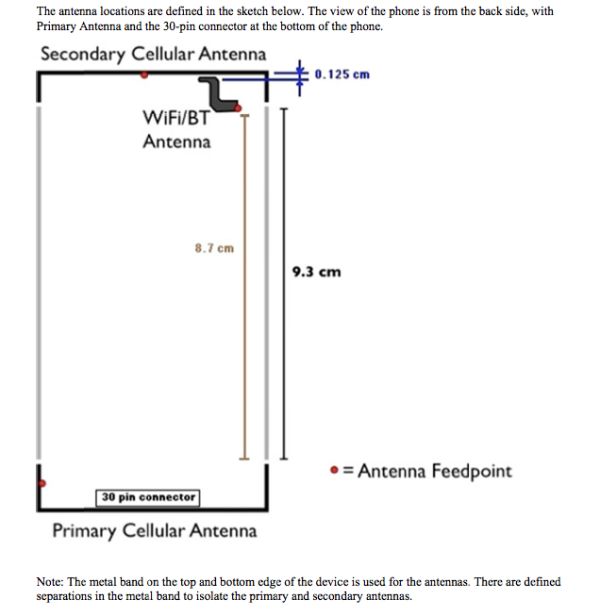
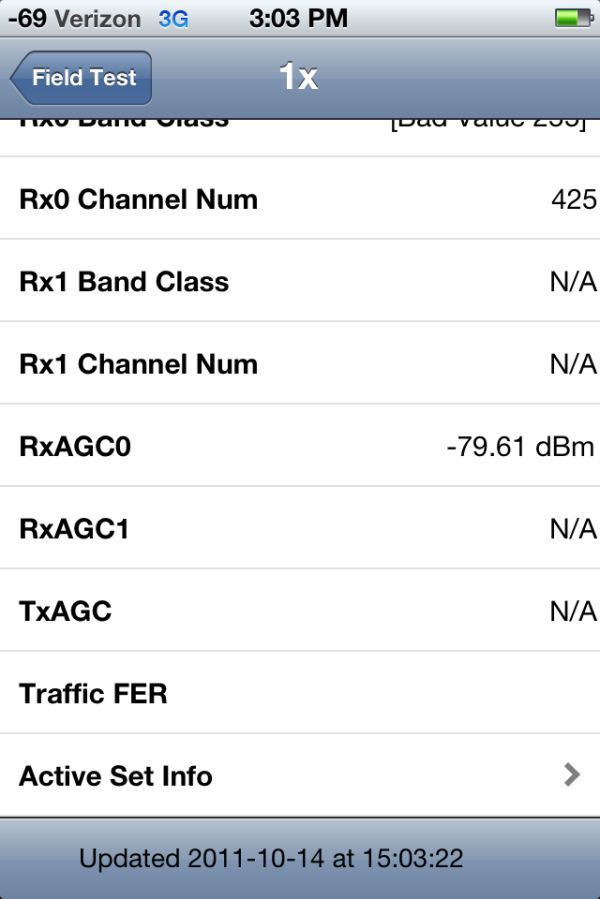
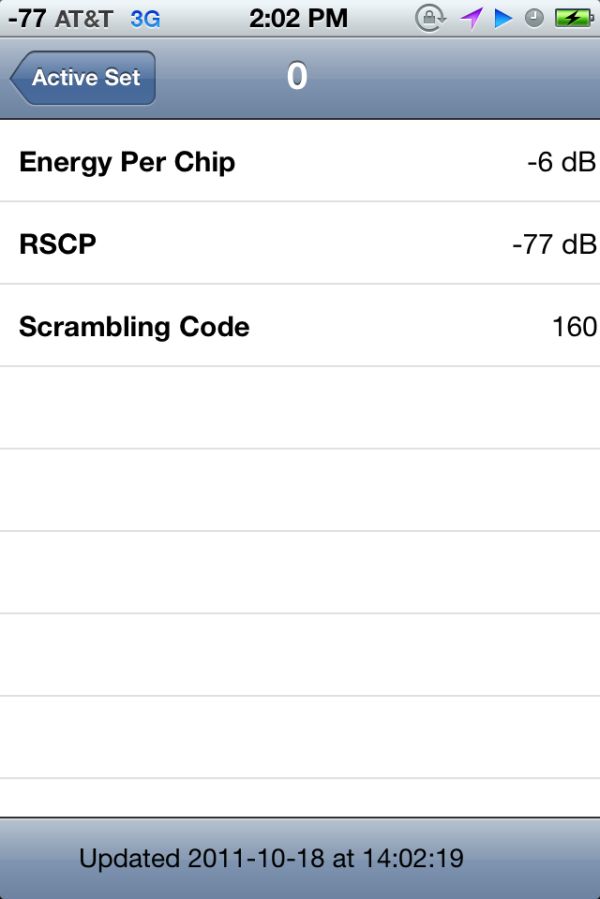








199 Comments
View All Comments
doobydoo - Friday, December 2, 2011 - link
Hardware wise, the difference between the iPhone 4S CPU/GPU combination and Android competitors, is huge.If you want the best performance, I don't see any other way to turn.
As for the software, I like most users would happily use Android or iOS - they've largely converged anyway.
name99 - Friday, November 4, 2011 - link
"If you had a 4 already your just a "moop" if you upgraded to one of these!"OK, so most US customers on on a 2yr plan. Upgrading for them is impractical, if for no other reason then for carrier reasons. And then you are COMPLAINING that Apple produced an upgrade that (in your eyes) gives them no reason to upgrade???
What exactly is your problem? You're like someone who goes to a restaurant and complains "the food sucks --- and the portions are too small".
dennykins - Tuesday, November 1, 2011 - link
Hey! I have that "Introduction to Modern Optics" book too! Pretty old, but still relevantname99 - Tuesday, November 1, 2011 - link
"It is admittedly curious that Apple hasn’t decided to make some other larger change to distinguish the 4S from the other two"There was, of course, also precious little visual change between iPhone, iPhone3G and iPhone 3GS. Likewise for plenty of other upgrades across the Apple line in the last ten years. I don't know why Anand thinks it's strange. For YEARS Apple has made the point that you buy an iMac --- and you get the what Apple thinks an iMac should be today. You don't buy an iMac XV371. You don't buy an iMac 7. You don't buy an iMac 20011. You buy an iMac --- which may or may not look like its predecessor, which may or may not have last been updated three, six or
nine months ago.
It's obvious that Apple wants to bring that same mindset to phones (and iPads). Screwing with people's expectations of an update in July was simply the first step in breaking the mindset of a particular schedule for upgrades. Of course there are issues that make it more difficult to do this cleanly, for example carrier involvement and the ridiculous subsidized pricing model --- which means that Apple has reason, at least for now, to keep older models around. But there are obvious advantages to Apple in switching to this model, including
- not being forced to release SW too soon. I think we'd all agree iOS5 was released under pressure, and that iOS 5.1 will be the release 5.0 should have been.
- Apple's been able to ignore pressure from a stream of constant Android updates for the past two years, but at some point annual upgrades may just be too slow. At that point it would be nice to have the option of minor upgrades (cf the recent PowerBook Pro upgrades), say boosting the CPU from 800 MHz to 1GHz, without it being a big deal --- something to shut up the crowd that looks at specs, while being ignored by the mass audience that does not care about specs and doesn't want Apple talking about them.
Not that this will stop haters from claiming that "people buy iPhones for fashion"....
KPOM - Tuesday, November 1, 2011 - link
Good observation about the upgrades. Yes, it's entirely possible we'll see minor spec bumps as the iPhone has become a staple of Apple's product line. We don't notice all the the upgrades in the Android world (how many people know or even care about the differences between the Galaxy S, Galaxy S II, and Galaxy S II Skyrocket ?), partly because they happen all the time.Also, Apple has never been a company to change the design simply for the sake of change. They tweak a design until they "get it right," but then stick with it a while. This year's MacBook Air, for instance, is a big update from last year's (Core i5/i7, backlit keyboard, 4GB RAM standard on most models), but they didn't change the external design. It's still selling extremely well and received good reviews. I think it's the same with the iPhone. The 4S has some significant improvements, from the faster processor, better camera, and better antenna.
name99 - Tuesday, November 1, 2011 - link
I'm glad you guys adopted my suggestion to report how snappy a phone feels, based not only on CPU benchmarks but also on the speed of flash, and things like the launch time of apps.In the spirit of constant complaint that is the web, can I now ask that you continue to do this for all future phones, not just iOS devices.
Yes, you have fanboi readers who care only about how wonderful their platform is; but you do also have a number of honest readers who are genuinely interested in things like how the speed of flash (including the speed of SD flash) varies across devices, and how launch times (for comparable apps) vary --- which, of course, depends on both HW and also SW/OS decisions.
Drasca - Tuesday, November 1, 2011 - link
There's a small typo that I'm surprised no one else has caught. Perhaps I am the only one that cares enough about this particular subject enough to. On the last page, 4th to last paragraph, we see:"we’ll hopefully see the technology mature into something more like what years of science fiction moves have promised us."
I believe you mean movies here.
I caught it in particular because I've been discussing amongst my friends how modern technology is the future promise of older science fiction. Oh gosh gee wiz, we have instant mobile communication across the globe, including video! We talk into our portable devices and they think for us. These devices are an extension of ourselves. In a way, we've become like the borg in that we're connected to community at large. Facebook is a form of hive mind group consciousness. Heck, we can track each other near-instantaneously and some folk are vividly aware of each other's locations.
These are interesting times, and what has only previously been explored as supposition has become reality.
I still want my flying cars and teleporters. Also, Holodecks and the AI behind it. Plus, the bridge of the starship enterprise D with its big comfy captain's chair and massive screen.
anishannayya - Wednesday, November 2, 2011 - link
If you want an iPhone, you really don't have a choice. Either you get the 4S or go find an Android phone.shashank7040 - Wednesday, November 2, 2011 - link
Asus Eee Pad being the first tablet With Slide out QWERTY........http://goo.gl/B4rJUthevibenow - Wednesday, November 2, 2011 - link
Check out our review of the Iphone 4shttp://www.youtube.com/watch?v=35v1kkaPM9s